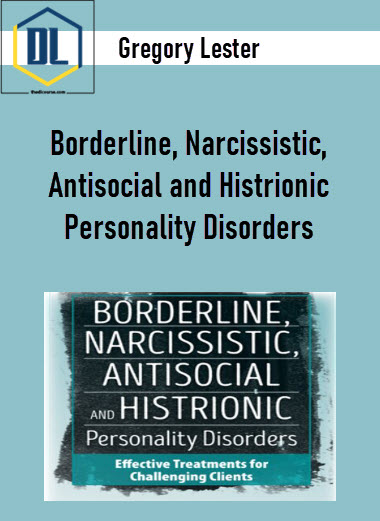Gregory Lester – Borderline, Narcissistic, Antisocial and Histrionic Personality Disorders
$109.00 Original price was: $109.00.$28.00Current price is: $28.00.
»Product Delivery: Instant Deliver
»Sale Page
Description
Gregory Lester – Borderline, Narcissistic, Antisocial and Histrionic Personality Disorders
Sale page: Gregory Lester – Borderline, Narcissistic, Antisocial and Histrionic Personality Disorders
Watch Dr. Gregory Lester as he delivers an intensive workshop recording designed to provide you with the knowledge, skills, and abilities to identify and treat your most difficult personality disordered clients. Better understand your clients with Antisocial, Narcissist, Histrionic and Borderline Personality Disorder and make a breakthrough in clinical treatment.
- Manage the manipulative and possibly violent Antisocial Personality Disorder in-session.
- Overcome the Narcissistic Personality Disorder trait of perfectionism and combat their need to overpower you as the therapist.
- Better understand your clients diagnosed with Histrionic Personality Disorder whose intense emotions and need for attention will test your patience and compassion.
- Help the Borderline Personality Disorder client deal with their explosive emotions, self-harm tendencies and cravings for chaos.
Case studies and video examples will be used to illustrate client symptom presentation, treatment, and management of each Cluster B client type. You will explore various modalities that are effective with antisocial, narcissistic, histrionic, and borderline personality disorders, such as Motivational Interviewing, Cognitive-Behavioral, Interpersonal, and Dialectical therapies. Each of these theories will be explored to provide you with solid and useable skills to include in your daily practice.
- Determine how the changes with the DSM-5® impacts diagnosis and treatment of the Cluster B Personality Disorders.
- Identify and diagnose clients with antisocial, narcissistic, histrionic and borderline Personality Disorders to effectively inform your choice of treatment interventions.
- Utilize case studies to differentiate symptom overlap, effective treatment and emotional management of each Cluster B Personality Disorders client type.
- Manage the manipulative and potentially violent behaviors with your clients diagnosed with Antisocial Personality Disorder in session to make therapeutic progress.
- Implement CBT techniques to clarify behaviors, values and goals with clients diagnosed with Narcissistic Personality Disorder.
- Incorporate techniques to decrease explosive emotions, self-harm tendencies and cravings for chaos for clients diagnosed with Borderline Personality Disorder.
- Utilize MI and DBT techniques with clients diagnosed with Histrionic Personality Disorder to help manage cognition and improve emotional regulation.
Understanding Personality Disorders
- Updates to DSM-5® and future changes
- The real purpose of diagnosis
- Treatment errors and misdiagnosis
- Core vs. surface structures
- Four central components to diagnosis
Antisocial Character
- Understanding psychopathology
- Developmental progress in childhood
- Oppositional defiance
- Attachment and family of origin
- Primary defenses and affects
- Importance of personal power
- Managing in-session violence
- Suicide attempts and threats
- Blockades – manipulation and power struggles
- Risk analysis to self and other
- Interpersonal theory techniques
- Transference and countertransference
- Lessen destructive behaviors
- Cognitive-behavioral techniques
- Psychopharmacology and applicability
- Case studies and treatment exercises
- Differential diagnoses
Borderline Character
- Symptom presentation along the spectrum
- Attachment and family backgrounds
- Feeling identification and behavioral control
- Manage rage, boundaries, self-mutilation and suicidality
- Facilitate pattern recognition, create stability, and build therapeutic collaboration
- Develop true sense of self and lessen maladaptive need for attention
- Underlying wishes and fears
- Build DBT core mindfulness skills
- DBT techniques to dissolve distraction, calm interpersonal upheavals, and focus on the “genuine relationship”
- DBT emotion regulation skills
- Psychopharmacology and applicability
- Case studies and treatment exercises
- Differential diagnoses
Narcissistic Character
- Narcissism and environmental contexts
- Attachment and family backgrounds
- Primary defenses and affects
- Tackle the veneer of perfectionism
- Blockades – power struggles, empathy and criticism
- The narcissistic/borderline client
- Interpersonal strategies for empathy
- CBT techniques to clarify behaviors, values and goals
- Tactics to avoid arguing
- Motivational interviewing to overcome resistance
- Prevent sabotage
- Build a sense of true self
- Psychopharmacology and applicability
- Case studies and treatment exercises
- Differential diagnoses
Histrionic Character
- Moody to excited to flamboyant: the erratic client
- Attachment and family backgrounds
- Primary defenses and affects
- Coquettish behavior, avoidance drama, inauthenticity
- Dangers of the histrionic client
- Link between emotions and behavior
- Interpersonal strategies for expression of true self
- Enhance sense of self and lessen the “spotlight”
- Motivational interviewing techniques
- DBT techniques
- Interpersonal strategies for positive relationships
- Strengthen self-initiative and independent action
- Psychopharmacology and applicability
- Case studies and treatment exercises
- Differential diagnoses
Delivery Policy
When will I receive my course?
You will receive a link to download your course immediately or within 1 to 21 days. It depends on the product you buy, so please read the short description of the product carefully before making a purchase.
How is my course delivered?
We share courses through Google Drive, so once your order is complete, you'll receive an invitation to view the course in your email.
To avoid any delay in delivery, please provide a Google mail and enter your email address correctly in the Checkout Page.
In case you submit a wrong email address, please contact us to resend the course to the correct email.
How do I check status of my order?
Please log in to TheDLCourse account then go to Order Page. You will find all your orders includes number, date, status and total price.
If the status is Processing: Your course is being uploaded. Please be patient and wait for us to complete your order. If your order has multiple courses and one of them has not been updated with the download link, the status of the order is also Processing.
If the status is Completed: Your course is ready for immediate download. Click "VIEW" to view details and download the course.
Where can I find my course?
Once your order is complete, a link to download the course will automatically be sent to your email.
You can also get the download link by logging into your TheDLCourse account then going to Downloads Page.
Related products
Donna Eden with David Feinstein – The Energies of Love: The Invisible Key to Fulfilling Relationship











